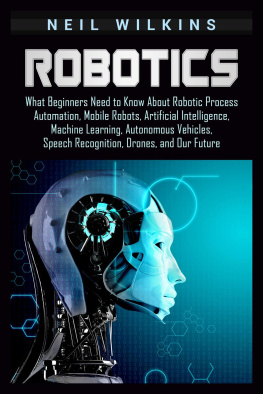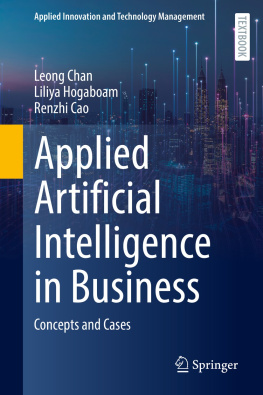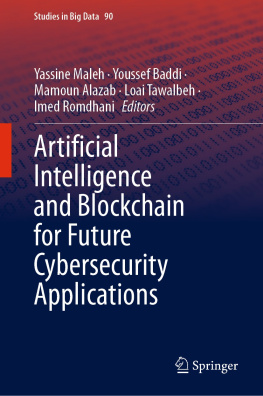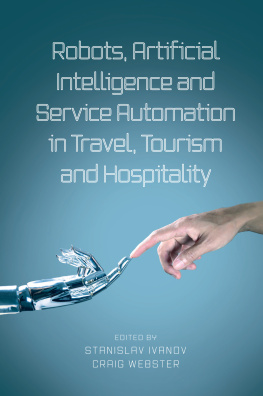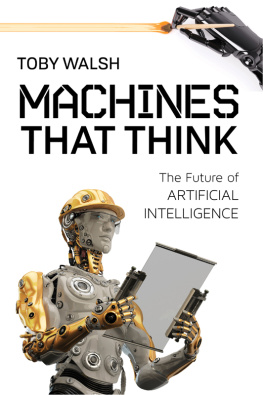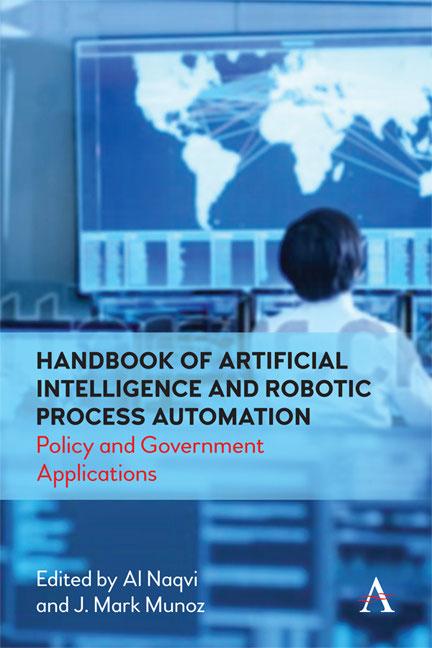Handbook of Artificial Intelligence and Robotic Process Automation
Handbook of Artificial Intelligence and Robotic Process Automation
Policy and Government Applications
Edited by
Al Naqvi and J. Mark Munoz
Anthem Press
An imprint of Wimbledon Publishing Company
www.anthempress.com
This edition first published in UK and USA 2020
by ANTHEM PRESS
7576 Blackfriars Road, London SE1 8HA, UK
or PO Box 9779, London SW19 7ZG, UK
and
Madison Ave #116, New York, NY 10016, USA
2020 Al Naqvi and J. Mark Munoz editorial matter and selection;
individual chapters individual contributors
The moral right of the authors has been asserted.
All rights reserved. Without limiting the rights under copyright reserved above, no part of this publication may be reproduced, stored or introduced into a retrieval system, or transmitted, in any form or by any means (electronic, mechanical, photocopying, recording or otherwise), without the prior written permission of both the copyright owner and the above publisher of this book.
British Library Cataloguing-in-Publication Data
A catalogue record for this book is available from the British Library.
ISBN-13: 978-1-78527-495-4 (Hbk)
ISBN-10: 1-78527-495-3 (Hbk)
This title is also available as an e-book.
CONTENTS
List of Illustrations
Chapter
J. Mark Munoz and Al Naqvi
PART I. STRATEGIC FRAMEWORKS OF AI
Chapter How to Build AI Country Strategy?
Al Naqvi
Chapter Governance of Artificial Intelligence
Nicholas Miailhe and Yolanda Lannquist
Chapter 4.0 and Evidence-Based Policies: AI and Data Analytics to the Rescue
Nathalie de Marcellis-Warin and Thierry Warin
Chapter Strategic Implications of Artificial Intelligence for International Security
Jean-Marc Rickli
PART II. AI AND ECONOMIC DEVELOPMENT
Chapter AI to Improve Economic Productivity: A Business Model Perspective
Oleksiy Osiyevskyy, Yongjian Bao, and Carlos M. DaSilva
Chapter Resultant Unemployment from Artificial Intelligence
Margaret A. Goralski and Krystyna Grniak-Kocikowska
Chapter Tech Zones to Enhance AI
Melodena Stephens
PART III. AI AND THE ENHANCEMENT OF GOVERNANCE
Chapter versus e-government: How to Reinvent Government with AI?
Al Naqvi
Chapter Governance When Humans and AI Are at Work
Dirk Nicolas Wagner
Chapter Systems at a Crossroads: Justice in the Age of Artificial Intelligence
Nicolas Economou and Bruce Hedin
Chapter Curious Case of Fake News: Fighting Smart Machiavellian Machines
Daniel Lemus-Delgado and Armando Lpez-Cuevas
Chapter of Artificial Intelligence and RPA to Improve Government Performance
Luis Soto and Sergio Biggemann
Chapter
J. Mark Munoz and Al Naqvi
Notes on Contributors
Index
ILLUSTRATIONS
Figures
2.1 The three roles of government
2.2 Strategy canvas for country strategy
2.3 Country strategy development
2.4 Integrated governance and country strategy
6.1 The impact of AI technologies on firm-level productivity
6.2 The impact of data availability on quality of machine and human decision-making
6.3 Value creation and capture in a firms business model
8.1 The four-level decision-making process for AI-tech cluster development
8.2 Agile learning
13.1 Intelligent automation
13.2 Old workflow
13.3 New workflow
Tables
between narrow AI and AGI
clustersoverarching policy and management decisions
for AI and RPA integration for governments phase agenda action plan
of the strategic AI/RPA plan for governments topic considerations
Chapter
INTRODUCTION
J. Mark Munoz and Al Naqvi
President Vladimir Putin of Russia was not hedging when he stated that the country that advances in artificial intelligence (AI) will rule the world. Neither was President Xi of China who has set the goal for China to become a global leader in AI. Europe, Canada, the United States, and other major economies of the world have already understood that the dawn of a new era has begun. The advanced economies also understand that unlike previous revolutions, this new era offers little or no examples of how to maneuver and navigate through this technological and economic puzzle. The glorious rise of intelligent machines is not an ordinary change. After all, the last time humans lived with an intelligent species was when Neanderthals and humans coexisted and that didnt work out too well for the Neanderthals. Fast forward thousands of years and once again humanity is challenged by another type of intelligence. This time however, it is our own creation. Throughout human history, machines have stayed as loyal and subservient servants to the commands of their creator master. Today, the advent of AI is poised to change all that.
The previous paragraph captures the essence of the challenge: humans are creating intelligence but have no experience in dealing with intelligent machines. However, the change is not limited to machines. It encapsulates the massive social, political, economic, psychological, and spiritual alteration that comes with an extraordinary change. In some ways, the essence of humankind is being redefined. This book is about that change, but it is written from the perspective of government. Unlike dozens of texts that have addressed the change from a business side, this is the first book that will address the role, responsibility, and challenge of managing AI from the government side.
In some ways, the advent of AI technology happened too soon and too unexpectedly. It is as if terminator robots and AI bots jumped out of a Hollywood flick and started breeding furiously. Within a seven-year period, the fascinating stories that ornamented comic books suddenly became the ultimate priorities of company boards and government leaders. Flash crashes in financial markets triggered by bot traders and bot armies invading democratic institutions became bleeding headlines. Institutions collapsed under the assaults of smart bots and companies crumbled as cyber warriors pierced through their firewalls. Individuals surrendered their rationality and judgment to the onslaught of opinion bots. As populist movements swept across the world, data-bots masterfully conquered the emotional spaces of the innocent victims and realigned psychological constructs and ideological structures of helpless humans. They didnt know what hit them. Hate spewed from multiple directions as bot armies were used to sway public opinion, and a sense of powerlessness took shape in human civilization. The important factor to note is that all of this happened in a matter of less than a decade, in technologically advanced economies, and with the machines that humans had built themselves.
The world was not prepared for such an enormous change. As soon as the world grasped the enormity of the challenge and what it meant, visionary and responsible governments scrambled to make sense of the dynamic and uncontrollable change. The White House issued multiple reports and formed task forces. The US Senate and Congress launched hearings. The European Union established policies and frameworks to deal with the enormity of the challenge. China launched multibillion dollar programs. Russia tried to take a central position in the transformation. Canada designated entire cities to create the AI revolution.


